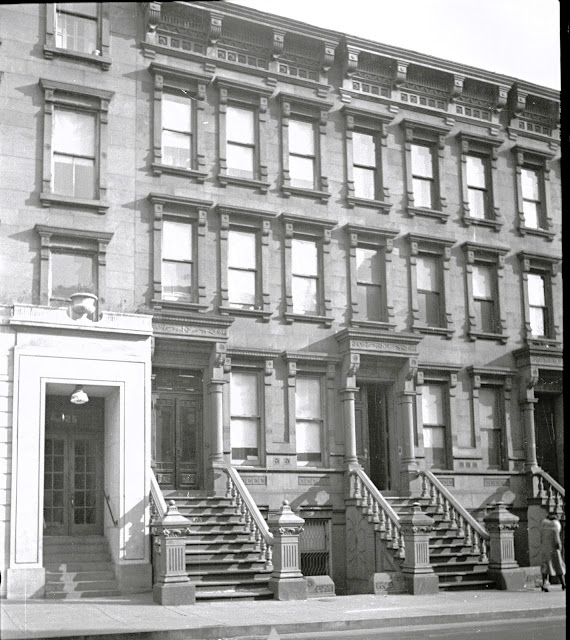In January 1885, the architectural firm of Cleverdon & Putzel filed plans for four neo-Grec style houses at 117-123 West 130th Street for developer Samuel O. Wright. The Record & Guide mentioned that three of the "brown stone houses" would be 19-feet wide, while one would be a foot narrower.
No. 123 West 130th Street, like its identical siblings, featured impressive architrave window frames with prominent sills and cornices. The double-doored entrance sat within an engaged portico with Tuscan columns that upheld an imposing entablature decorated with carved designs.
Benjamin G. and Sarah M. Disbrow purchased 123 West 130th Street on May 1, 1890. The couple had four adult sons, Griffin B., George A., Dr. Robert N., and Charles A. Benjamin would not enjoy his home for long, dying on March 19, 1892.
Disbrow's death created a contentious rift in the family. On October 16, 1892, The New York Sun headlined an article, "Mr. Disbrow Left Two Wills." One will was executed on February 7, 1891 and the other on January 18, 1892. The first left Sarah "the income of certain property for life," and gave Griffin "$1,500 and some furniture in the family residence." He and George (who received the upright piano) were given the bulk of the estate. Their brothers, Charles and Robert, each received $4,500 (about $155,000 in 2024). The will explained, "I have not given more of my property to my two sons, Charles and Robert, on account of their undutiful conduct to my wife and to me."
A month before their father's death, Charles and Robert had apparently made amends and he had written the second will. Now Griffin and George faced off in court against their brothers and their wives. They contested the second will, alleging "undue influence" of their brothers "while Mr. Disbrow was in feeble health and of unsound mind." Robert and Charles simultaneously contested the first will.
Within a month, things got more complicated (and heated). On November 16, The Evening World reported that two more wills had been discovered. "The Disbrow family was apparently full of discord, and Benjamin made four wills during the last year of his life," said the article, which predicted, "a fight over the disposition of his property...bids fair to continue many months."
The property that was to provide Sarah income for life was a rental building at 108th Street and Lexington Avenue. And that, too, resulted in family drama. Griffin managed the property for his mother. Five years after her husband's death, Sarah sued to have Griffin removed as trustee. Her lawyer said he "employed himself as agent to collect the rents and has paid himself for such services." In addition, Griffin told his mother that repairs to the building "ate up all the profits," according to The World on November 14, 1897.
Griffin and Sarah would face off once again three years later. On November 8, 1900, The New York Times reported, "A somewhat remarkable controversy between a mother and her son recently received final decision in the Court of Appeals." On April 27, 1892, a month after Benjamin Disbrow's death, Sarah transferred title to 123 West 130th Street to Griffin "in consideration of love and affection and the sum of one dollar." Then, in 1897 she sued to reverse the transfer. The judge at the time ruled, "Mrs. Disbrow was unquestionably misled as to the nature and effect of the instrument."
Griffin appealed. On November 7, 1900, the court ruled that although, "she was an inexperienced woman, and she leaned upon her son Griffin," there was no evidence that he had exerted undue influence. The judges, reported The New York Times, "were constrained" to return ownership of the house to Griffin.
Sarah M. Disbrow moved to the Brooklyn home of her son, Robert. She died there on May 23, 1912 at the age of 82.
Former Tammany Hall leader and Supreme Court Justice Peter Aloysius Hendrick and his wife, the former Julia Sherwood, lived at 123 West 130th Street at least through 1907. Born in Penn Yan, New York in 1858, Hendrick came to New York in 1887 and "for a time [was] personal counsel to Charles F. Murphy," the Tammany boss. He was appointed to State Supreme Court in 1906 earning the equivalent of $612,000 per year in today's money.
The Hendricks were followed in the house by William J. Farrell. He was president of the William J. Farrell Company, described by The New York Times as "one of the largest dealers in dressed poultry, butter, and eggs in the city."
Farrell, who was unmarried, was at Fort Covington, New York on June 18, 1919, when he suffered a "stroke of apoplexy," according to The New York Times. (The term referred to what today is known as a stroke.) The article said, "Specialists from New York were rushed to his bedside, but they could do nothing for him."
The house was inherited by Annie M. Farrell and Mary Ellen Higgins, presumably his sisters. They sold it in April 1921 to Samuel and Florette Graham. Samuel died nine months later, on January 20, 1922.
In 1941, the stoop railings and newels survived. image via the NYC Dept of Records & Information Services.
In 1941 the house was converted to unofficial apartments. Among the initial residents were Alice and Samuel Simmons. Samuel left to fight in World War II, and on February 23, 1946, The New York Age reported that Alice, "has been informed that her husband, Samuel has been promoted to the grade of corporal. He is serving as a dispatcher with the 810th Engineer Aviation Battalion near Manila."
By the turn of the 21st century, the once-proud house was operated as a single-room-occupancy building. Then, a renovation completed in 2004 resulted in a three-family residence.
photograph by the author
no permission to reuse the content of this blog has been granted to LaptrinhX.com


.png)

No comments:
Post a Comment